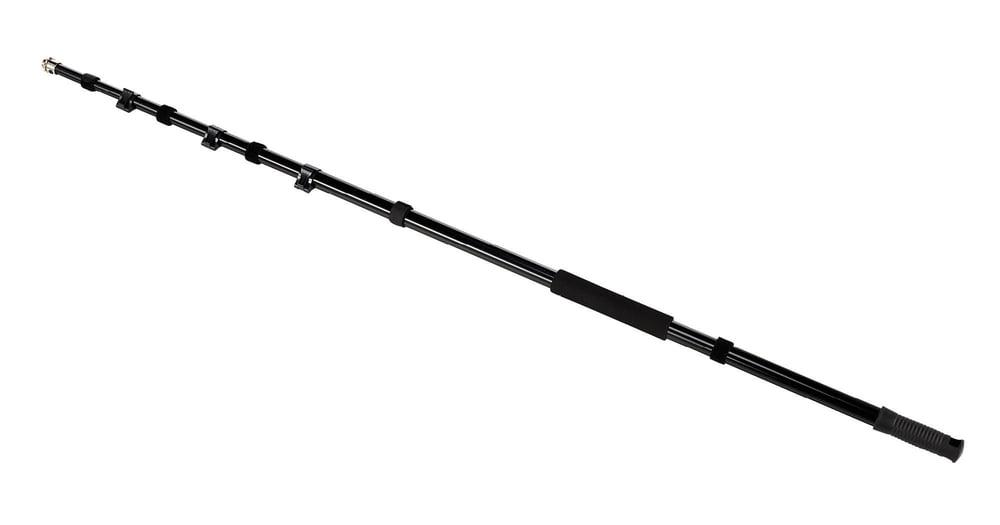2. Stands and mounts
In most cases, you’ll want to attach your microphone somewhere. There are various options to accomplish this.
Straight microphone stands
Straight microphone stands are available with a round base or with three folding legs. Straight stands with a round base are very simple. The base usually consists of a cast iron disk, to which the lower end of the pole is attached. The upper section of the pole slides into the lower section, which allows you to adjust the height. Round base stands are extremely sturdy. The heavy base gives them a low center of gravity, which makes them stable and hard to tip over. Microphone stands with foldable legs tend to work better than round base stands on uneven surfaces, but their legs can be a tripping hazard.

order code 133138 - Millenium MS 2004 and order code 483763 K&M 20150
Straight microphone stands work best for singers who don’t play an instrument. The round base stand became associated with highly energetic lead singers. Tilting the stand like Elvis and similar moves are only possible with a round base stand. Some straight stands feature a one-handed clutch, which makes it very easy to adjust the height.
They’re less suitable for guitar, bass or keyboard players, as the straight pole tends to interfere with the instrument. But there are some three-legged straight stands that can also tilt.
Boom stands
Boom stands are the most common microphone stands. They’re made up of a tripod base and a lockable joint, which connects the lower stand to the upper part, the so-called boom. Boom stands are perfect for singers who play an instrument, because they don’t get in the way of an instrument held in front of your body. Boom stands are versatile and can also be placed off to the side.

order code 158894 - Millenium MS 2005
Boom stands can easily adapt to various instruments and playing positions. With an adjustable height and flexible joints, they give you enough space to move around. But not all boom stands are equally stable. Heavy stands tend to be more secure than lighter ones, but this is usually reflected in a higher price, as well.
Special sizes: low-profile stands and overhead stands
Some positions are out of reach of a traditional boom stand. For micing the bass drum or guitar and bass amps, low-profile tripod stands are a great choice. Regular-size boom stands tend to take up too much space for these applications. Low-profile stands are more stable, less of a tripping hazard and usually less expensive.
Normal boom stands are often too short for drum overheads. And the further you extend the boom, they less stable they become. For this reason, dedicated overhead stands are a better choice for this application. Overhead microphones can be expensive and delicate, so you shouldn’t cheap out on the stands. Some large overhead and choir microphone stands can be equipped with casters, and some have bases that can be secured with extra weights.

order code 130531 - Millenium MS 2002 and 210883 K&M 21430
Desktop stands
Small desktop microphone stands are mostly used for interviews. They’re included with some microphones typically used by reporters.

order code 395760 - Gravity MS 3122 HDB
Desk-mounted microphone arms
These flexible microphone arms are especially popular in broadcasting. Radio DJs need to have their hands free and often need to move from one device to the next, without the listeners noticing. Desk-mounted microphone arms are a popular solution. They’re constructed in a similar way as desk lamps and can be positioned quickly and securely within their operating range.

order code 442382 - Millenium MA-2040
Modular solutions
Modular microphone stand systems are also available. They often feature quick release systems that let you attach various microphone clamps or booms with a simple click. One advantage of modular systems is the huge variety of available accessories. This ranges from fixed wall mounts to double booms to clamps that attach to other stands, desks and much more.
Boompoles
Boompoles are essential for capturing audio on location during film and video shoots. Fully extended, their length allows the boom operator to capture sound while hiding the microphone from the camera.

order code 401523 - Millenium Boompole L
Instrument clips
For attaching a microphone directly to various instruments, a wide variety of clips and clamps is available. There are clips for string, brass and woodwind instruments, guitars, drums, and more. Some microphones are available with complete sets of clips that let you attach the microphone to nearly any instrument.

different instrument adapters









